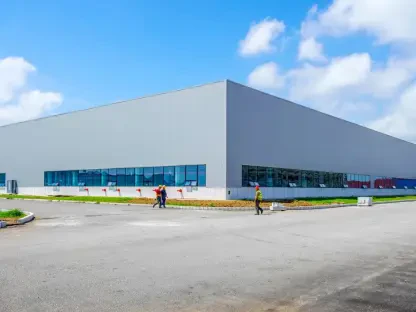The meteoric rise of online shopping is set to propel e-commerce to an astonishing $5.3 trillion by 2028, revolutionizing warehousing and logistics. In the face of this explosive growth, businesses face the complex challenge of managing vast inventories with precision. Nokia’s Automated Inventory Management System (AIMS) stands at the forefront of this evolution, offering a cutting-edge solution that aims to transform warehouse operations. The advent of AIMS signifies a critical shift towards more efficient, error-free inventory handling, preventing costly missteps in a rapidly changing industrial landscape. As companies grapple with the increasing demands of e-commerce, systems like AIMS become not just advantageous, but essential in their quest for seamless logistics and inventory control.
The Drawbacks of Traditional Inventory Management
Within the confines of traditional inventory management lies a time-intensive, error-prone process that can no longer keep pace with the vaulting demands of contemporary commerce. Manual inventory counting, akin to tedious slogging through quicksand, is marred by inaccuracies and inefficiencies. These antiquated practices often culminate in financial abrasions for entities, hemorrhaging resources into a system fraught with the risks of human error and escalating operational expenditures.
Nokia’s AIMS: A Technological Leap Forward
Nokia’s AIMS is revolutionizing inventory management by harnessing the power of artificial intelligence and autonomous drones. This cutting-edge system utilizes advanced computer vision to offer a new, highly efficient approach to cycle-counting. The integration of these smart drones overcomes the physical constraints of human workers, providing an unprecedented level of speed and accuracy in tracking stock. By automating inventory checks, AIMS significantly cuts down the time traditionally required for these tasks, facilitating a more productive warehouse environment. With this innovation, Nokia is transforming inventory management into a streamlined and more reliable process, offering businesses the ability to optimize their operations and ensuring that inventory data is always up-to-date and precise.
Efficiency and Productivity Gains with AIMS
The efficiency furnished by AIMS is nothing short of revolutionary. An autonomous drone, gliding through a quarter-million square-foot warehouse, completes an inventory scan in mere weeks—a feat up to seven-fold quicker than its human counterpart. This stark augmentation means that labor, once squandered on the mundane task of count verification, can now be reallocated, propelling productivity and curtailing cycle counting’s exorbitant toll on resources.
Financial Implications and ROI
AIMS offers a compelling financial benefit with a conservative estimated return on investment (ROI) exceeding 40% over three years. Businesses that have integrated AIMS into their processes report significant improvements. By efficiently uncovering unused stock, AIMS plays a critical role in resource management. The system results in falling labor expenses and reducing losses from unaccounted inventory, or “shrinkage.” Additionally, AIMS mitigates costs related to equipment upkeep. The tool’s tangible benefits in inventory control are clear, solidifying AIMS as an essential component in cost-effectively managing inventory. Its proven track record in boosting profitability makes it an attractive option for companies looking to enhance their bottom line. As such, AIMS is not just a tool for inventory; it’s a transformative agent for fiscal efficiency.
Enhancing Strategic Decision-Making
AIMS not only streamlines processes but sharpens the strategic acumen of decision-makers. Armed with real-time data and comprehensive analytics, managers can adeptly navigate the currents of inventory ebb and flow, seizing the helm of their company’s fiscal fate. Enhanced decision-making capabilities, bolstered by precise data, can deftly foster a company’s upward financial trajectory.
Reimagining Warehouse Workforce Roles
As inventory counting becomes a thing of the past, workers are liberated from its monotonous grip, thanks to advances like Nokia’s AIMS. This shift not only frees up employee time but also redirects their efforts towards more valuable pursuits. With the burden of cycle counting lifted, the workforce can pivot to enhancing customer relations and engaging in activities that directly contribute to the bottom line. As they engage in these more profitable tasks, employees play a crucial role in the company’s growth, strengthening its foundations to better withstand the unpredictable movements of the marketplace. This strategic reallocation underscores a forward-thinking approach to business – optimizing human resources where they’re most effective, thereby ensuring a company’s resilience and continued success in a competitive economic landscape.
Addressing the Challenges of Modern Warehouses
AIMS answers the call of modern warehousing, a realm beleaguered by labor shortages, inflating property costs, and the relentless squeeze of inflation. This system reimagines inventory management as a fluid, automatable task, providing a bulwark against operational inefficiencies. The ubiquitous woes of the warehousing sector find solace in the embrace of AIMS’ technological prowess.
AIMS as a Scalable and Flexible Solution
Nokia’s Automated Inventory Management System (AIMS) is a testament to adaptability in warehouse management. It is designed to be a versatile solution, easily shaping itself to fit warehouses of all shapes and sizes, as well as their individual operational demands. This system acts much like a chameleon, seamlessly integrating into various warehouse environments without causing disruptions.The true allure of AIMS lies in its ability to mold its functionality to the specific needs of any given warehouse, taking into account its unique characteristics. Its flexible scheduling options are particularly noteworthy, as they allow for inventory scans to be conducted during periods of low activity. By doing so, AIMS ensures that the vital flow of warehouse operations remains uninterrupted. This approach not only maximizes efficiency but also minimizes the potential for operational friction.The inherent scalability of AIMS makes it an ideal choice for a diverse range of warehouse types, from smaller facilities to sprawling complexes. Regardless of the size or function of the warehouse, AIMS is up to the task, providing a seamless and tailored inventory management experience. This level of customization and adaptability is what sets Nokia’s AIMS apart as a leading solution in warehouse management.
The Competitive Edge Provided by AIMS
In the cutthroat race of e-commerce, AIMS offers businesses the wings to soar. This avant-garde technology enables entities to navigate fulfillment demands adeptly, preserving, if not expanding, their market foothold. Companies employing AIMS can pivot with alacrity, surging ahead of the stagnating tide of those entangled in the vestiges of antiquated inventory management practices.
The Future of Warehouse Management with AIMS
As progress marches on, AIMS stands at the forefront, offering a bright future for warehouse management. Though not flawless, its impact is significant, forever altering how we handle inventory. As Nokia continues to enhance AIMS, the landscape of inventory management is expanding. The days when logistics represented a bottleneck in business are waning. Instead, with each update to AIMS, logistics are transforming into a smooth, efficient channel. This shift points to a time when the handling of goods and organization of warehouses are no longer impediments but rather facilitators of commerce. With AIMS, Nokia is shaping an era of streamlined operations, where technology and practicality converge to create an optimized flow of goods. The promise of this system is not in its infallibility but in its continuous evolution and adaptability, which promises to make warehouse management smarter and more agile.









